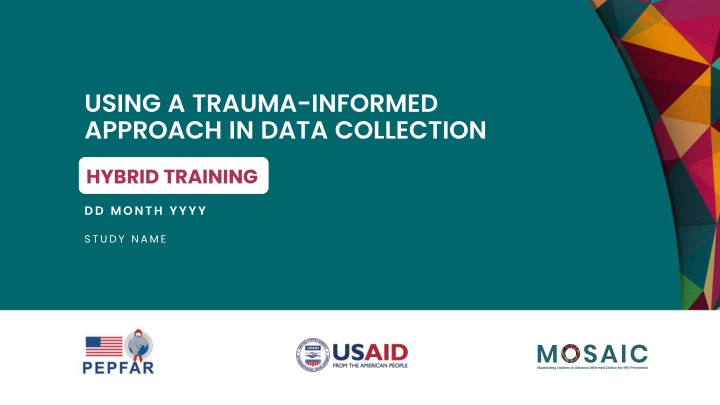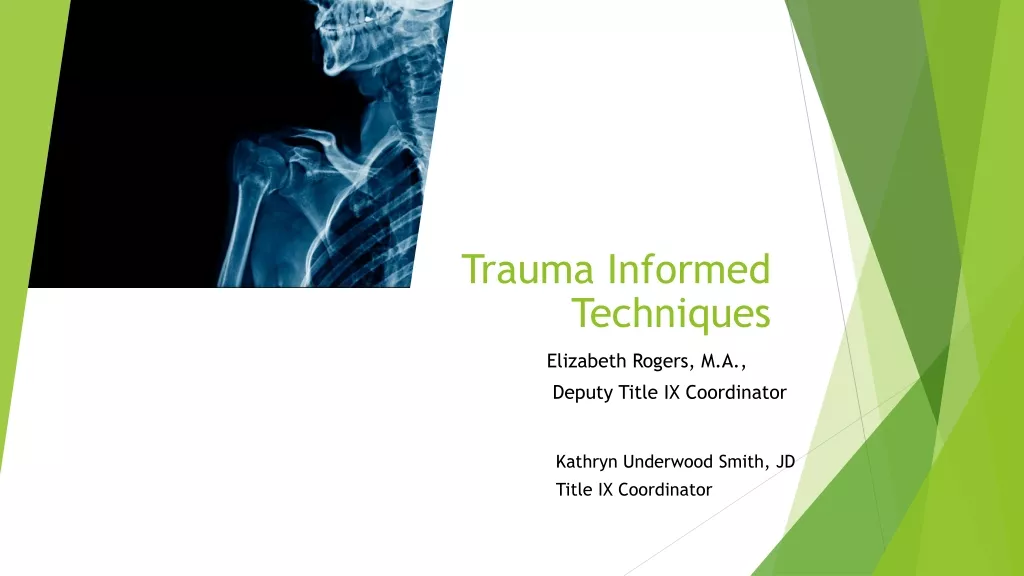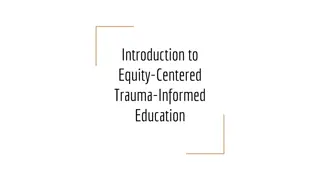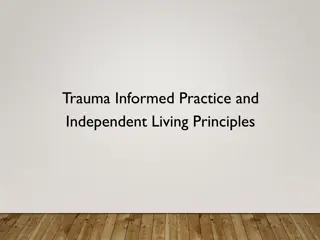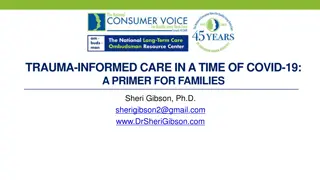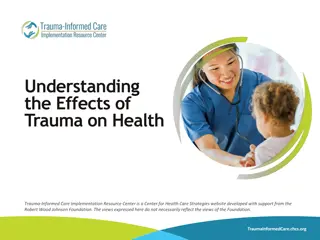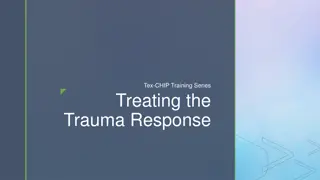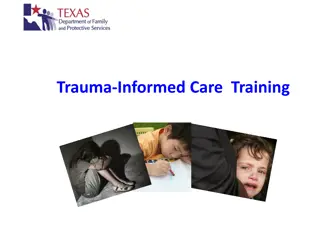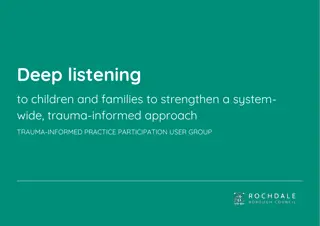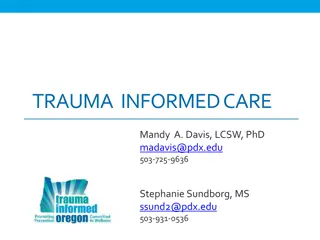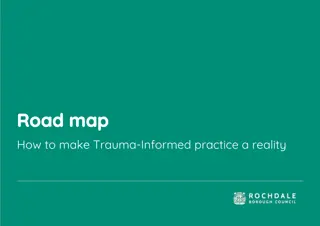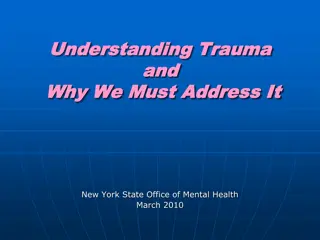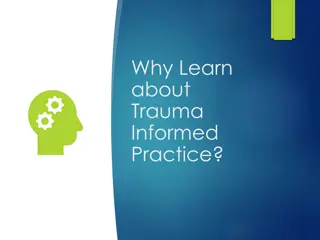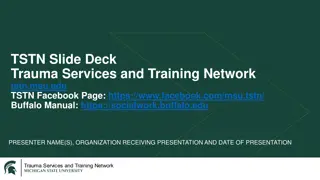Trauma-Informed Approach in Data Collection Hybrid Training Study
Today's training focuses on applying a trauma-informed approach in data collection to minimize harm and aid in recovery. Participants will learn about compassion fatigue, self-care strategies, creating safe spaces, and responding to distress. Group agreements and logistics are outlined to ensure a supportive learning environment.
Download Presentation

Please find below an Image/Link to download the presentation.
The content on the website is provided AS IS for your information and personal use only. It may not be sold, licensed, or shared on other websites without obtaining consent from the author.If you encounter any issues during the download, it is possible that the publisher has removed the file from their server.
You are allowed to download the files provided on this website for personal or commercial use, subject to the condition that they are used lawfully. All files are the property of their respective owners.
The content on the website is provided AS IS for your information and personal use only. It may not be sold, licensed, or shared on other websites without obtaining consent from the author.
E N D
Presentation Transcript
USING A TRAUMA-INFORMED APPROACH IN DATA COLLECTION HYBRID TRAINING DD MONTH YYYY STUDY NAME
HOW TO PARTICIPATE TODAY: CHAT & REACT Please introduce yourself in the chat! Name Study site Something that makes a good learning environment for you
HOW TO PARTICIPATE TODAY: POLLS How do you feel in this moment? Mark the face that best represents how you feel. Go to www.menti.com and enter the code #### #### Or use QR code
OUR GOAL TODAY Our research addresses many sensitive topics that can invoke or involve trauma in study participants and those undertaking the research process. Our goal today is to apply a trauma-informed approach to data collection to minimize harm to both study participants and data collectors and aid in their paths to recovery.
OUR LEARNING OBJECTIVES 1. 2. Identify ways to apply a trauma-informed approach in data collection. Describe the importance of using a trauma-informed approach in data collection. Identify signs of compassion fatigue and vicarious trauma. Recognize your feelings and needs when engaging with sensitive topics. Explore self-care strategies to prevent or reduce compassion fatigue and vicarious trauma. Explore organizational support that is available. Describe ways to create a physically and emotionally safe space for study participants. Describe the steps to ask study participants about violence. Demonstrate practical skills in identifying and responding to distress, including acknowledging and validating experiences and offering support and warm referrals. 3. 4. 5. 6. 7. 8. 9.
OUR GROUP AGREEMENTS Recognize that we are all learners and teachers; be open to learning from each other. Practice active listening and active participation. Be mindful and respectful of mind, body, spirit, and emotions (for ourselves and others!). Respect each other s privacy. Keep personal experiences confidential. What else is missing? Share your responses in the chat box. Share responsibility for success. Remember that all methods of contribution are valuable. Be supportive of one another.
QUICK HOUSEKEEPING & LOGISTICS Keep our group agreements top of mind. Join session from a space that allows your active participation (e.g., quiet, distraction-free space). Participate in ways that work best for you. This can include typing in the chat box, using the mic to speak, and answering the check-in polls. Use a notebook to capture your thoughts and questions. This will help you to explore and revisit your reflections. Please prioritize your mental health and well-being; if you need to step away at any time, know that we support you in doing so. Let us know if you need anything.
TODAYS AGENDA Time Session 15 min Opening Session 1: Understanding trauma-informed data collection 20 min Session 2: Taking care of ourselves and each other 30 min 10 min Break Session 3: Creating a safe space for participation 20 min Session 4: Identifying and responding to participant distress 30 min 45 min Session 5: Practicing our skills 10 min Closing
1 UNDERSTANDING TRAUMA-INFORMED DATA COLLECTION
TRAUMA Trauma refers to experiences of events or circumstances that are physically or emotionally harmful or threatening and provoke feelings of being powerless, overwhelmed, or deeply distressed. Key Points Trauma can result from a single event, a series of events, or a set of circumstances. People respond to potentially traumatic experiences in different ways. Experiences become traumatic when they overwhelm a person s ability to cope. Trauma can have lasting adverse effects on a person s mental and physical health and well-being.
Trauma-Informed Practices in Data Collection TRAUMA-INFORMED 1. Be aware that trauma affects many aspects of a person's identity, relationships, worldview, and coping behaviors. Provide trauma-specific resources to aid in person s recovery. Engage in a partnership with the participant in which each person's knowledge is valued. 4. Provide participants with choices, options, and a sense of control over their actions and decisions in the research process. 5. Strive for comfort, privacy, and psychological and physical safety in the research space. Protect participant confidentiality and provide clear information about role and expectations. 6. Reassure survivors that trauma coping is normal and recognize that trauma symptoms may come from their efforts to cope. 7. Recognize ways in which the research may be retraumatizing. Avoid intrusive or insensitive research procedures that could trigger trauma- related symptoms. A trauma-informed approach Realizes the widespread impact of trauma Recognizes signs and symptoms of trauma Responds in policies, procedures, and practices Resists re-traumatization 2. 3. How might we apply a trauma-informed approach to data collection? Source: SAMHSA. Practical guide for implementing a trauma-informed approach. SAMHSA; 2023 Source: Adapted from Campbell et al. A trauma-informed approach to sexual violence research ethics and open science. J Interpers Violence. 2019;34(23 24).
LETS REFLECT What might be some of your warning signs that you are starting to feel distressed and that you should reach out for support (for example, heart racing, throat getting tight, getting irritable, spacing out)? What can you do to minimize the chances of having these feelings or manage their impact (for example, stepping away or slowing down, or checking in with someone)?
Why are trauma-informed approaches needed for data collection? Study participants and data collectors may have a history of trauma or be close to people who do. Some may disclose their traumatic experiences and ask for help. Study participants may Data collectors may Feel distress or be retraumatized when asked about sensitive topics like violence Be at risk of retaliatory violence from perpetrators if confidentiality is broken Find it empowering to speak out and share their experience through research Be exposed to study participants accounts of traumatic experiences Experience vicarious trauma or compassion fatigue when they interact with traumatic stories or content Be retraumatized if they have a history of trauma Find it empowering to work closely with and listen to trauma survivors
LETS DISCUSS What might an untrained data collector think about these study participants? Thandeka shows up late for interviews and regularly fails to pick up her oral PrEP refills. Naeku tells you that she always uses her PrEP ring, but she receives a positive HIV test result. Lerato screams at a nurse when the nurse tells her she will have to wait one hour for her CAB PrEP injection.
LETS DISCUSS How would the data collector s opinion about the study participants change after knowing the full situation? Thandeka, whose controlling partner does not allow her to go to the site, shows up late for interviews and regularly fails to pick up her oral PrEP refills. Naeku tells you that she always uses her PrEP ring, but she tests positive for HIV after a violent partner forcibly removed it and destroyed it. Lerato, who was just kicked out of her home and has not slept for two nights, screams at a nurse when the nurse tells her she will have to wait one hour for her CAB PrEP injection.
2 TAKING CARE OF OURSELVES AND EACH OTHER
TRAUMA EXPOSURE Being exposed to traumatic stories and content such as listening to study participants painful experiences can have an impact on a data collector s well-being and can lead to compassion fatigue and vicarious trauma.
Go to www.menti.com and use the code #### #### What comes to mind when you hear well-being? Type one word to create a word cloud.
WELL-BEING Well-being refers to the state of feeling healthy, safe, and content. It is a subjective experience based on how an individual evaluates their life overall, which may include: physical health, emotional stability, social connections, and sense of purpose. Our overall well-being can impact how our work affects us. For example, if we are dealing with traumatic situations or hardships outside of work, we may be more likely to experience compassion fatigue or vicarious trauma.
COMPASSION FATIGUE Someone who is experiencing compassion fatigue may: Feel tired, stressed, and overwhelmed Feel irritable and short- tempered Have trouble finding joy and happiness in life Feel down or depressed Have difficulty connecting with those around them Become desensitized to traumatic content Compassion fatigue refers to the experience of feeling emotionally and physically exhausted as a result of helping others and being exposed to traumatic stories or content. These feelings build up over time, and we may not be aware of them until we feel completely overwhelmed. Compassion fatigue is experienced differently by different people. What are signs that someone may be experiencing compassion fatigue? Share your responses in the chat box.
Someone who is experiencing vicarious trauma may: Experience unwanted and recurring thoughts or images about other people s traumatic experiences Feel deep anger or sadness at how unfair the world is Feel numb to the pain of the world Feel helpless or hopeless Lose trust in people and a sense of personal safety Lose sight of the positive things in the world and see only the negative VICARIOUS TRAUMA Vicarious trauma, sometimes called secondary trauma, refers to experiencing trauma symptoms as a result of being personally affected by other people s traumatic experiences. If we are exposed to traumatic stories or content on a regular basis, we may start to have an unbalanced, depressing view of the world. It is a common response to engaging with traumatic stories or content on a regular basis. What are signs that someone may be experiencing vicarious trauma? Share your responses in the chat box.
VICARIOUS RESILIENCE Some find this work improves their well-being by: Giving them a sense of purpose and meaning Giving them strength and inner power Strengthening feelings of hope, inspiration, and fulfilment Although data collectors may experience compassion fatigue and vicarious trauma if they are regularly exposed to study participants traumatic experiences, this type of work does not automatically lead to compassion fatigue and vicarious trauma. Instead, they may experience positive impacts from working closely with and listening to trauma survivors. This is called vicarious resilience. Do these concepts resonate with you? Share your responses in the chat box or by unmuting your mic. Source: Billing L, et al. We Care: evidence review. Pretoria: Sexual Violence Research Initiative; 2021.
Go to www.menti.com and use the code #### #### Think about a time when you discussed a sensitive topic with a study participant. How did you feel? Mark the word that best represents how you felt. Examples of feelings when needs are fulfilled Amazed Energetic Inspired Optimistic Stimulated Comfortable Fulfilled Intrigued Proud Surprised Confident Grateful Joyful Refreshed Touched Eager Hopeful Moved Relieved Trustful Examples of feelings when needs are not fulfilled Afraid Confused Distressed Helpless Overwhelmed Angry Disconnected Embarrassed Hopeless Reluctant Annoyed Disappointed Fatigued Lonely Sad Concerned Discouraged Frustrated Nervous Uncomfortable Source: Adapted from the Center for Nonviolent Communication
Go to www.menti.com and use the code #### #### What were your needs? Mark the word that best represents what your need was. Think about a time when you discussed a sensitive topic with a study participant. Examples of needs CONNECTION PHYSICAL WELL- BEING MEANING AUTONOMY PLAY Acceptance Creativity Choice Fun Food Cooperation Growth Freedom Humor Movement Compassion Purpose Independence Joy Rest Respect Self-expression Space Safety Trust Understanding Spontaneity Water Source: Adapted from the Center for Nonviolent Communication
SELF-CARE Caring for myself is not self-indulgence, it is self-preservation, and that is an act of political warfare Self-care is intentionally taking care of ourselves and meeting our needs. Practicing self-care means listening to our bodies, feelings, and thoughts, which allows us to identify our needs. The earlier we identify and respond to our needs, the easier it is to prevent ongoing unwanted thoughts, vicarious trauma, and compassion fatigue. Using self-care to prevent and deal with vicarious trauma and compassion fatigue can lead to a greater sense of hope, purpose, and feeling that life has meaning. Audre Lorde, A Burst of Light (1988) Reclaiming self-care as a political act: Reasserts our value and right to care Gives us permission to practice self- and collective care Challenges root causes of care deficits
LETS REFLECT There is no right or wrong way to practice self-care. Each person is different, and what works for one may not work for another. So, it is important to choose what works best for you! Think about a time when you felt stressed, exhausted, or overwhelmed at work. 1. What did you need for your own well- being? Consider emotional, physical, social, and other aspects of well-being. 2. How did you meet your needs? If comfortable, share your responses in the chat box or by unmuting your mic.
LETS REFLECT Circle strategies you would like to include in your self-care practice. Examples of self-care strategies Take walks Get regular medical care Spend time outdoors Meditate Take time off when you are sick Express gratitude Read favorite books Get enough sleep Reach out to loved ones Bake Create art Take a break from technology Do light exercise Cook Garden Laugh in the company of friends Write in a journal Take vacations Listen to music Play sports Do breathing exercises
ORGANIZATIONAL CARE STRATEGIES To support data collectors to protect their well-being, the study teams will: Study procedures and training Operationalize procedures and training on safeguarding, safety monitoring and reporting, and responding to participant distress and disclosures of traumatic experiences Provide training to recognize and mitigate compassion fatigue and vicarious trauma. Workload management Set time limits for data collection events . Cap the number of data collection events per day and days per week . Schedule adequate breaks between data collection events . Engage in data collection not more than five days a week . Balance and rotate responsibilities to minimize exposure to traumatic content. Supportive supervision Convene regular supervisory debrief meetings and wellness checks, including providing psychological first aid and linking to other support as needed. Create other opportunities for staff and peer support. Wellness activities Explain what workplace wellness activities are available to data collectors and how to access those activities. Local services Explain what services are available to data collectors and how to access those services.
LOCAL SERVICES DIRECTORY Health Services Social Services Legal Services Organization/Facility Location Focal Point Contact Info Services Available Hours of Service Costs of Services (is it free for research staff? for study participants?) How to Access Services (is referral required?)
3 CREATING A SAFE SPACE FOR PARTICIPATION
Go to www.menti.com and use the code #### #### What roles can data collectors fill in trauma- informed data collection? Select all that apply. a. Create a safe space for study participants to talk about their experiences. b. Pay attention to signs of distress. c. Diagnose study participants with mental health conditions such as anxiety and depression. d. Provide psychological first aid if a study participant shows signs of distress and/or discloses a traumatic experience. e. Provide counseling if a study participant shows signs of distress and/or discloses a traumatic experience. f. Refer study participants to providers who are trained to provide counseling and further support.
DATA COLLECTORS ROLE You are not trained mental health counselors; however, the way you respond to a person in distress can make a significant difference to their well-being. Do s Don ts Create a safe space for study participants to talk about their experiences. Diagnose study participants with mental health conditions. Pay attention to signs of distress. Provide counseling. Provide psychological first aid if a study participant shows signs of distress and/or discloses a traumatic experience. Remember, without the right training, we can do more harm than good if we try to counsel others! Refer study participants to providers who are trained to provide counseling and further support.
CREATING A SAFE SPACE A safe space is both physically and emotionally safe. In a safe space, study participants can trust they will not be judged, rejected, or stigmatized. This helps them feel comfortable being themselves and participating fully and honestly.
CREATING A SAFE SPACE IN PRACTICE How do you typically create a safe space? Share your responses in the chat box or by unmuting your mic. Techniques What does this look like in practice? Meet in a private space where the participant feels physically safe. Is here okay or is there somewhere else you would feel more comfortable? Is there anything I can do or be aware of to help you feel safe during this [survey/interview/focus group discussion]? Listen closely with empathy and without judgement. I m here to listen to and learn from you. I won t judge you or tell you what to do. You are the expert in the room today, and I want to learn from you. Let them know they can trust you to protect their confidentiality. I will keep everything you tell me confidential, unless you give me permission to share it. Your full name will not be attributed to anything you share today. Maximize participant choice and control. You do not have to answer any questions that you do not want to answer. You can share as much or as little information as you want. Build in pauses and hold space for emotions. Please take your time. I am here when you are ready. Take your time, there is no pressure.
EXAMPLE OPENING OF A DATA COLLECTION TOOL Good morning/afternoon/evening. Thank you for speaking with us today. As I mentioned, we d like to speak to you about how HIV prevention and pre-exposure prophylaxis (PrEP) choices are viewed in this community. As part of this study, we are conducting focus group discussions with parents and caregivers of adolescent girls and young women in your community who might decide to use PrEP at some point. Explain why study participants are in the room (i.e., study goals and objectives). We want to understand what you think parents roles are in supporting or not supporting their child s use of PrEP and how the community views the use of PrEP . Does this explanation make sense? Pause for questions. Also, I want you to know that I am a member of research team, and I have no judgement regarding anything that you share. This is a learning process for us. We really want to hear your honest responses. There is no right or wrong answer to any of these questions. Explain that you are not there to judge them or anything they share. We encourage everyone to participate, knowing there are no right or wrong answers. Please share your opinion, even if you disagree with someone. We really want to know what you think. And please be respectful if someone shares something that you don t agree with. Help them feel confident and comfortable sharing. Remind them their privacy is protected. What might you add or remove? What might you say differently? Share your responses in the chat box or by unmuting your mic. Everyone deserves to be able to share their opinions today without worrying that their opinions might be shared with people outside this room. Everyone in this room has agreed to keep our conversation confidential; we will ask you again not to share any of the information shared today with others.
ASKING ABOUT VIOLENCE Why ask about intimate partner violence in a study about PrEP choice? In addition to using the techniques to create a safe space, data collectors should follow these steps when asking about violence: Intimate partner violence affects end-user interest and willingness to use PrEP and their ability to initiate and continue using different methods of PrEP; in some cases, it acts as a barrier to PrEP use, while in others it acts as motivator for PrEP use. 1. Explain why you are asking about violence in advance. 2. Ask permission to ask about violence. 3. Ask about violence. 4. Make it easy to skip questions. 5. If study participant answers Yes to any violence question, provide first-line support.* 6. If study participant answers No or No response to all violence questions, thank them and let them know about services available to anyone who has experienced violence. *Study participants may also disclose experiences of violence when not expected (e.g., when reporting a social harm or responding to qualitative questions).
4 IDENTIFYING AND RESPONDING TO PARTICIPANT DISTRESS
DATA COLLECTOR TECHNIQUES Create a safe space Identify and respond to participant distress (psychological first aid) Meet in a private space where they feel physically safe. Recognize signs of distress. Listen closely with empathy and without judgement. Acknowledge and validate their experiences. Let them know they can trust you to protect their confidentiality. Offer options for support and follow their lead. Maximize participant choice and control. Build in pauses and hold space for emotions.
RECOGNIZE SIGNS OF DISTRESS Do not pressure a study participant to share details about why they are distressed. Instead, use pauses to give study participants space to process and take care of themselves and provide them with psychological first aid. Pay attention to changes in body language, facial expressions, tone, and words to detect signs of distress. Are they having difficulty concentrating? Are they breathing more heavily? Are they restless or fidgeting? Are they getting irritable? Are they becoming agitated? Did their mood suddenly change to low or no emotion? Example: It sounds like you re feeling upset. It can be hard to talk about these experiences. Should we take a break?
ACKNOWLEDGE AND VALIDATE Techniques What does this look like in practice? Acknowledge and validate their experiences. Thank them for sharing and acknowledge that sharing can be difficult. I appreciate you sharing that with me. It can be hard to talk about these experiences. Make it clear you believe them. I believe you. Let them know it is not their fault. What happened has no justification or excuse. Related techniques Listen closely with empathy and without judgement. Build in pauses and hold space for emotions. Use their language/acknowledge their feelings. There is no right or wrong way to feel. Your feelings are valid. Help them feel supported, not judged. I m glad that you spoke to me about this. You are not alone. I am here for you.
MESSAGES TO AVOID Avoid statements that: Place blame on the survivor Say anything that judges what the survivor has done or will do Question the survivor s story (doubting) or interrogate the survivor Say anything that minimizes how the survivor feels Lecture, command, or advise Recommend that they change their profession, sexual orientation, or gender identity to avoid violence Avoid questions that suggest fault (examples below). Why were you wearing such revealing clothes? What did you do to make the perpetrator angry? If you were really afraid, why didn t you run or scream? Why do you choose to put yourself in risky situations? Asking why questions about trauma can feel like asking a survivor to justify something about their experience. We want to think twice before asking why questions, as this puts the onus on the trauma survivor.
Be sure to get participant agreement before connecting them to any other staff, including service providers! SUPPORT Techniques What does this look like in practice? Offer options for support and follow their lead. Ask if they would like to hear information on support and resources. Staff at this site are trained to support you. Can I connect you with them? If a study participant does not want to speak to another staff person, share referral options: I d like to share information with you about available services that can support you. Is that okay? If yes, let them know they are in control of how they want to move forward. Any of these options are valid, and I am here to support you in whichever one (if any) you choose. It is your choice what happens next, and I m here to support you. Related technique: Maximize participant choice and control. Help connect them to support and resources if desired. [If no] If you decide you would like some support in the future, just let me know and I can give you some information. [If yes, provide information and make referral.]
PROVIDING INFORMATION ABOUT REFERRALS Take time to familiarize yourself with referral resources that are available in your area. Offer to help the study participant make an appointment by calling the referral person/organization for them (ask the client in advance what information about their experience or needs should be shared), making a call with the study participant, or offering a private place where the study participant can make a call. When making referrals, share only the information that the study participant has agreed can be shared; all other information about the study participant must be kept confidential. Offer printed copies of the study referral directory, if safe and appropriate for the study participant. Do not pressure the study participant to accept a referral or to give details about an incident. Offer yourself as a resource if the study participant wants referrals in the future.
ZURIS STORY Zuri is an 18-year-old university student. She lives with her partner, Ouma. Ouma often raises his voice at Zuri when they have disagreements, and sometimes he slaps or hits her when he s been drinking. Zuri is not using PrEP yet, but Ouma usually agrees to use condoms when they have sex. One day, as Zuri is getting ready for school, Ouma tells her that she wouldn t use condoms if she truly loved him and was faithful to him. Zuri is very upset and feels she must prove that she loves Ouma by having condomless sex with him. But she s not sure if Ouma has other partners, and she does not know his HIV status. She decides to explore her PrEP options at a local health center and enrolls in the study.
ZURIS STORY While going through the study enrollment questionnaire, the data collector asks Zuri about violence. Has a sexual partner ever punched, slapped, kicked, bit or caused you other physical harm? I m not sure if I can tell you. It s really important that no one knows what happened. Imagine you are the data collector. What would you do or say next? Share your responses in the chat box or by unmuting your mic.
ZURIS STORY I will keep anything you say confidential, but you can skip any question you wish at any time. You can share as little or as much information as you want. Your answers will be kept confidential. You don t have to answer any questions that you do not want to answer. Take your time. I am here when you are ready. Related techniques Let them know they can trust you to protect their confidentiality. Maximize participant choice and control. Build in pauses and hold space for emotions. What else?
ZURIS STORY It s my boyfriend. He slaps me sometimes only when he s drunk. I m afraid of what he ll do if I keep asking him to use condoms. I ve never told anyone about this before. What would you do or say next? Share your responses in the chat box or by unmuting your mic.
ZURIS STORY Thank you for sharing this with me. It can be hard to talk about these experiences. I believe you. Nobody deserves to experience violence. Related techniques Listen closely with empathy and without judgement. Build in pauses and hold space for emotions. Acknowledge and validate their experiences It sounds like you feel afraid. What else?
ZURIS STORY I m not sure what to do. What do you think I should do? What would you do or say next? Share your responses in the chat box or by unmuting your mic.
